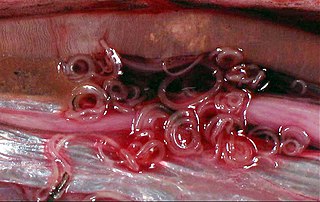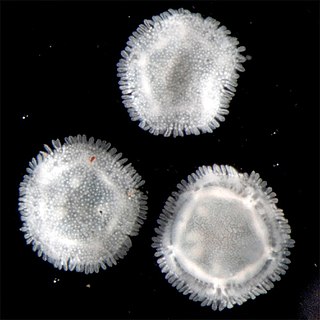
The mustard plant is any one of several plant species in the genera Brassica and Sinapis in the family Brassicaceae. Mustard seed is used as a spice. Grinding and mixing the seeds with water, vinegar, or other liquids creates the yellow condiment known as prepared mustard. The seeds can also be pressed to make mustard oil, and the edible leaves can be eaten as mustard greens. Many vegetables are cultivated varieties of mustard plants; domestication may have begun 6,000 years ago.

The Chromadorea are a class of the roundworm phylum, Nematoda. They contain a single subclass (Chromadoria) and several orders. With such a redundant arrangement, the Chromadoria are liable to be divided if the orders are found to form several clades, or abandoned if they are found to constitute a single radiation.

Pratylenchus penetrans is a species of nematode in the genus Pratylenchus, the lesion nematodes. It occurs in temperate regions worldwide, regions between the subtropics and the polar circles. It is an animal that inhabits the roots of a wide variety of plants and results in necrotic lesions on the roots. Symptoms of P. penetrans make it hard to distinguish from other plant pathogens; only an assay of soil can conclusively diagnose a nematode problem in the field. P. penetrans is physically very similar to other nematode species, but is characterized by its highly distinctive mouthpiece. P. penetrans uses its highly modified mouth organs to rupture the outer surface of subterranean plant root structures. It will then enter into the root interior and feed on the plant tissue inside. P. penetrans is considered to be a crop parasite and farmers will often treat their soil with various pesticides in an attempt to eliminate the damage caused by an infestation. In doing this, farmers will also eliminate many of the beneficial soil fauna, which will lead to an overall degradation of soil quality in the future. Alternative, more environmentally sustainable methods to control P. penetrans populations may be possible in certain regions.
Pratylenchus vulnus is a species of plant pathogenic nematode best known for infecting Persian walnut. It is also known to infest potatoes, apricots, peaches and nectarines, holiday cacti, grape and citruses.
Xiphinema diversicaudatum is an amphimictic ectoparasitic nematode species. This species has a characteristically long stylet capable of penetrating into a host's vascular tissue. They have a wide host range with some of the extensively studied ones being strawberry, hops and raspberry, due to their economic importance. The direct root damage caused through penetration near the root tip and formation of galls is a secondary concern when compared with the damage caused by vectoring the Arabis mosaic virus. The virus attaches to the interior cuticle lining and can be transferred from infected to uninfected root tissue as the nematode feeds and sheds. Management of this particular nematode relies on nematicides such as 1,3-Dichloropropene (Telone) at 40 gpa.or methyl bromide at 1000 lb/ac to control to 28 in deep.

Pratylenchus is a genus of nematodes known commonly as lesion nematodes. They are parasitic on plants and are responsible for root lesion disease on many taxa of host plants in temperate regions around the world. Lesion nematodes are migratory endoparasites that feed and reproduce in the root and move around, unlike the cyst or root-knot nematodes, which may stay in one place. They usually only feed on the cortex of the root. Species are distinguished primarily by the morphology of the stylets.

Nematophagous fungi are carnivorous fungi specialized in trapping and digesting nematodes. Around 160 species are known. Species exist that live inside the nematodes from the beginning and others that catch them, mostly with glue traps or in rings, some of which constrict on contact. Some species possess both types of traps. Another technique is to stun the nematodes using toxins, a method employed by Coprinus comatus, Stropharia rugosoannulata, and the family Pleurotaceae. The habit of feeding on nematodes has arisen many times among fungi, as is demonstrated by the fact that nematophagous species are found in all major fungal groups. Nematophagous fungi can be useful in controlling those nematodes that eat crops. Purpureocillium, for example, can be used as a bio-nematicide.
Tylenchorhynchus is a genus of nematodes including many species of plant parasites. The classification of stunt nematodes - those including the genus Tylenchorhynchus - is unstable; many newly discovered species within this genus are reconsidered to be actually subspecies. Stunt nematodes such as Tylenchorhynchus and the closely related genera, Anguillulina and Merlinia, include more than 250 known species. Members of these genera possess similar anatomy and may be easily mistaken for one another. Some debate has led to the classification of single species under different names in two distinct genera.

The nematodes, roundworms or eelworms constitute the phylum Nematoda. They are a diverse animal phylum inhabiting a broad range of environments. Most species are free-living, feeding on microorganisms, but there are many that are parasitic. The parasitic worms (helminths) are the cause of soil-transmitted helminthiases.
The red ring disease of coconuts and African oil palms is caused by the nematode Bursaphelenchus cocophilus. It is also identified in literature with an alternative scientific name Rhadinaphelenchus cocophilus. The common name, the red ring nematode, is derived from its distinguishing symptom.

Fenimorea janetae, common name Janet's turrid, is a species of sea snail, a marine gastropod mollusk in the family Drilliidae.
Anatoma janetae is a species of sea snail, a marine gastropod mollusk in the family Anatomidae.

Fenimorea is a genus of carnivorous sea snails, marine gastropod mollusks in the family Drilliidae.
Lucernaria janetae is an exceptionally large stalked jellyfish discovered on deep-sea hydrothermal vents on the East Pacific Rise in 2003 and described in 2005.

Lucernariidae is a family of stalked jellyfish containing two genera.

Xyloplax janetae is a Xyloplax of the family Xyloplacidae. It lives on the surface of wood sunken to abyssal depths.
Legerella is a genus of parasitic alveolates of the phylum Apicomplexa. Species in this genus that usually infect the malpighian tubules of invertebrates.
Enoplida is an order of nematodes. It is one of two orders in Enoplia, which is one of two subclasses in Class Enoplea.
Nepytia janetae is a species of moth in the family Geometridae . It was described by Frederick H. Rindge in 1967 and is found in North America.
Dorylaimopsis is a genus of nematodes belonging to the family Comesomatidae.









